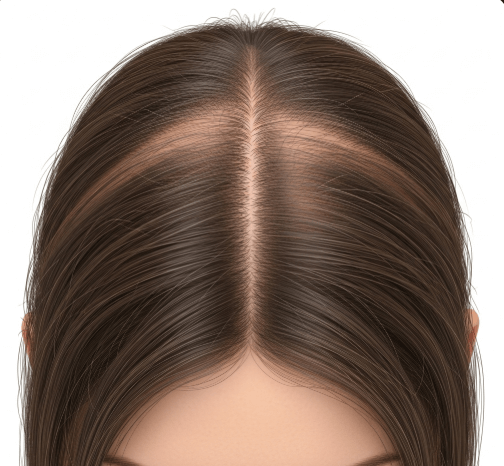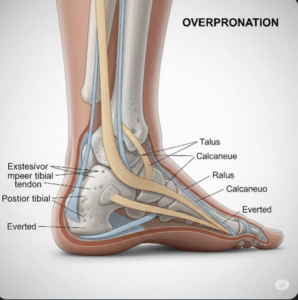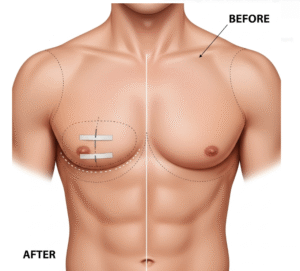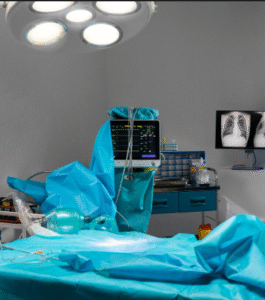🟢 What it is
Female Pattern Hair Loss (FPHL), also called female androgenetic alopecia, is the most common cause of progressive thinning in women. Unlike male pattern baldness, which usually follows a receding hairline and bald spots, FPHL is characterized by:
- Diffuse thinning over the crown and top of the head
- Preserved frontal hairline in most cases
- Widening of the part line as a key early sign
In Korea, FPHL is treated with a multi-layered approach combining medical, regenerative, and scalp-care therapies, since women often cannot use the same strong hormonal medications prescribed to men.
🟢 Why it Happens
The main contributors to FPHL include:
➡️ Genetics & hormones: Sensitivity to dihydrotestosterone (DHT) plays a role, though less aggressively than in men.
➡️ Aging: Hair follicles miniaturize naturally with age.
➡️ Hormonal changes: Pregnancy, childbirth, menopause, and conditions like PCOS.
➡️ Chronic stress: Can trigger telogen effluvium that worsens FPHL.
➡️ Nutritional factors: Iron deficiency, low vitamin D, or other imbalances.
➡️ Scalp health: Chronic inflammation, oil imbalance, or poor circulation.
🟢 Why it’s Treated in Korea
In Korean aesthetics and dermatology, hair health is strongly tied to youth and beauty. Women seek treatment for FPHL to:
- Slow or stop progressive thinning
- Increase density and hair shaft thickness
- Restore confidence and youthful appearance
- Prevent the need for surgical options later
Korean doctors emphasize early treatment, since miniaturized follicles can be revived if caught in time.
🟢 Alternatives and Treatment Options in Korea
🔹 Medications
- Topical Minoxidil (2% or 5%) → First-line therapy, prolongs growth phase.
- Oral Low-Dose Minoxidil (LDOM) → Increasingly prescribed in Korea under supervision.
- Anti-androgens (Spironolactone, Cyproterone Acetate, Drospirenone, etc.) → For women with hormonal imbalances or PCOS.
- Oral Finasteride/Dutasteride → Sometimes used off-label in post-menopausal women.
🔹 Regenerative Therapies
- PRP (Platelet-Rich Plasma): Growth factors repair follicles and boost density.
- Exosome Therapy: Next-generation regenerative vesicles for stronger follicle activation.
- Polynucleotide (PN) Injections: Salmon DNA-based boosters for scalp repair and circulation.
- Scalp Mesotherapy: Nutrients (HA, peptides, vitamins) delivered to follicles.
- Dr. CYJ Hair Filler: HA + biomimetic peptides for follicle stimulation.
- Regenera Activa: Autologous micro-grafts containing progenitor cells.
🔹 Device-Based Treatments
- Low-Level Laser Therapy (LLLT): Red light caps or domes stimulate follicles and circulation.
- Microneedling Scalp Therapy: Creates microchannels and boosts absorption of serums/PRP.
🔹 Surgical Option
- Hair Transplant (FUE/FUT): For advanced FPHL with significant follicle loss. Often used cautiously in women due to diffuse thinning.
🔹 Supportive Care
- Scalp scaling & detox: Improves follicle environment.
- Nutritional supplements: Iron, vitamin D, biotin, amino acids.
- Topical serums & tonics: To complement in-clinic therapies.
🟢 Preparation
Before starting treatment in Korea:
➡️ Scalp and hair density analysis using dermatoscope or digital imaging.
➡️ Blood tests: To check iron, thyroid, hormones, and vitamin D levels.
➡️ Medical history: Pregnancy status, PCOS, menopause, medications.
➡️ Lifestyle review: Stress, sleep, and nutrition assessment.
➡️ Expectation setting: Treatments slow progression and improve density, but require long-term consistency.
🟢 How it’s Done (Typical Program in Korea)
- Baseline medical therapy (usually minoxidil ± anti-androgens for suitable patients).
- Regenerative boosters every 2–4 weeks (PRP, exosomes, mesotherapy, PN, or Dr. CYJ filler).
- LLLT or microneedling sessions weekly to stimulate follicles.
- Scalp care treatments monthly (detox, scaling, oxygen therapy).
- Regular follow-ups every 3–6 months to track density and adjust protocols.
Most Korean clinics offer package programs lasting 3–6 months, then recommend maintenance every 6–12 months.
🟢 Recovery
FPHL treatment in Korea is usually gentle with little downtime:
🔹 Medications: Initial shedding possible with minoxidil before regrowth stabilizes.
🔹 Injections (PRP, exosome, mesotherapy): Mild tenderness/redness for 1–2 days.
🔹 Laser therapy: No downtime.
🔹 Results:
- Shedding slows after 2–3 months.
- Visible thickening at 4–6 months.
- Full results at 9–12 months, maintained with continued therapy.
🟢 Complications
⚠️ Medications:
- Minoxidil → irritation, unwanted facial hair if misapplied.
- Anti-androgens → menstrual changes, breast tenderness, fatigue.
⚠️ Injectables:
- Redness, tenderness, bruising (temporary).
⚠️ Rare risks:
- Infection from injections (minimized with sterile technique).
- Hormonal medication side effects (monitored in clinics).
🟢 Treatment Options in Korea
Korean dermatology clinics tailor FPHL treatment by age, severity, and cause:
- Younger women (20s–30s): Preventive scalp boosters + topical/oral minoxidil.
- Women with hormonal imbalance (e.g., PCOS): Anti-androgens + mesotherapy or PRP.
- Perimenopausal women: PRP + exosomes + minoxidil for density.
- Post-menopausal women: Dutasteride/finasteride (off-label) + regenerative therapies.
- Advanced cases: Hair transplant combined with ongoing medical therapy.
🟢 Final Thoughts
Female Pattern Hair Loss in Korea is treated as a chronic, manageable condition, requiring a multi-layered, personalized approach.
➡️ Best outcomes come from early intervention before follicles are permanently lost.
➡️ Results are gradual but natural-looking, aligning with Korea’s philosophy of subtle, long-term rejuvenation.
➡️ With Korea’s advanced regenerative therapies, customized medications, and scalp care programs, women can preserve density, restore confidence, and slow the visible effects of FPHL.
In summary: Female Pattern Hair Loss in Korea is best addressed through a holistic program combining medical, regenerative, and supportive therapies, designed for safe, effective, and sustainable results.













